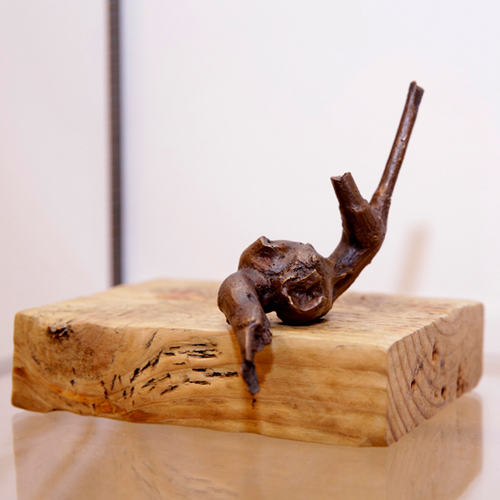everything is precious
everything is precious, sakshi gallery, mumbai, 2018
display design by Pravir Sethi, studio hinge
You can’t burst a bronze balloon, neither can you blow it away. How will you make a wish?
For Ratna Gupta, repetition is sacred. The act of doing, over and over, what has become instinctive, is a way of unearthing new meaning, to mark the passage of time and the metamorphoses of bodies. Many of her sculptural objects, at once strange and familiar, echo this obsession with recurrence and transmutation, though her practice doesn’t suggest a desire for permanence, but instead reaffirms the ephemeral. Ratna’s works are all ultimately subject to disintegration in the same way our bodies are—resin may crack, latex might morph, needles will rust, and things will fall apart.
In everything is precious, Ratna invites viewers into this fragile, intimate world where memories are cast into objects and the body is in flux. The works on display reconcile with restlessness and pain, the awareness of death and ecological degradation, but are also filled with a deep sense of wonder and surprise that asks us, above all else, to consider the things that we hold dearest.
Take a breath. Do a dance.
There is a glint of mischief just under the lustrous terrain of these odd shapes. At first, a humour in conjecture, an escalating game to imagine what might once have been buried under a flood of adhesive. A pipe, a glove? A beehive; a tortoise shell wrapped in cling. The skeleton of an immaculate bonsai held up to a fierce gust. Perhaps a balloon frozen in the throes of deflation as punishment for its mediocrity.
I like to believe that I make no sense.
Humour slowly recedes as a strange seduction takes hold. As with the sensual shapes of Bourgeois or the apparently genderless, floating bodies of Hesse, the eye begins to steal glances, moving excruciatingly over textural incongruities. Desire emerges alongside primal curiosity, a sudden urge to touch, taste, and to consume in an attempt to know these objects more intimately. Surfaces glisten like wet skin and suspended orbs invite confidential observations of the light filtering through their insides. The erotic is inextricably tangled with danger and death here; languid ink is suffocated in plaster, copper wires pierce through latex, and needles, tender and brush-like on first appearance, begin to shimmer threateningly as they punctuate lingering curves and unending edges. Pain lurks just on the precipice of pleasure, and leaves wounds to decipher.
You can’t undo what you do.
A reverence for the space grows from this sense of danger, an eerie fascination with the attempt to freeze the temporal and bring movement within the grasp of the synthetic. What time are we in? Are we surrounded by fossils? Are these insects of a purer earth, or markers of a contaminated one? This is, after all, a room filled with toxic material, corpses, and detritus, remnants of a contemporary wasteland, not dressed up as Recycled Art, but presented in their bare, mutational forms. Contained within are shadows of human figures, perhaps Giacometti’s gangly man, halted mid-stride by nuclear destruction, or Degas’s fourteen-year-old—poised in ballet position three—facing a roiling chemical cloud.
What does memory leave behind? Dust, or a shadow, or rust?
As bodies are constantly transformed in a slow, entropic violence, we’re left attempting to fill silence with gestures and absence with things, things that become both constant reminders of death and flickering fragments of former lives. While the meaning of objects we hold close might change with time, so do the objects themselves, and in their last moments, they too will warp out of shape, fold awkwardly at the joints that hold them together, and ultimately break in places that were once immutable.
– Arnav Adhikari







































































